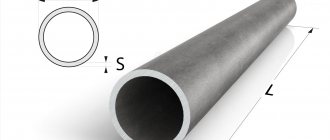When carrying out work in the house and in the country, we often need to bend pipes to give them the shape we need to perform our specific task. In order for the pipe to bend correctly and the pipe to serve for a long time, we will need a special machine, a pipe bender. These machines are sold in stores; there are many varieties and models, but our task will be to make a pipe bender with our own hands.
Pipe bender device
There are simply a huge number of different types of the device in question. Before creating it yourself, you should develop a drawing of a pipe bender or download it on the Internet.
You can make a pipe bender for a round pipe with your own hands, taking into account the following features of its design:
- Run-in. This type of pipe bending machine is characterized by the fact that one end of the workpiece is fixed, and a stationary template is used for bending. Running in is carried out using pressure rollers. This manual pipe bender design has been used for many years.
- Winding. A special pipe bender for aluminum pipes is characterized by the fact that the workpiece is pressed against a movable template, which is used as a roller. The broaching is carried out between the roller in motion and a special stop. As a rule, the drive is electric, since the required force is quite high.
- Crossbow design. This scheme is represented by a combination of two fixed rollers, as well as a movable template. The force is transmitted to the workpiece through a movable template, which is located between two rollers. By controlling the movement of the moving element, the most suitable bending angle is selected. It is worth considering that the pipe bender punch, which acts as a template, can have a different shape.
- Rolling or rolling. In this case, the scheme is represented by a device with three rollers, two of which are supporting and one is movable. The bending radius is adjusted by changing the position of the central roller. It is worth considering that such a device is considered universal, since the bending radius can be adjusted over a fairly large range. The dimensions of this type of pipe bender are relatively small; a homemade design can be compact.
When choosing the most suitable design for home-made production, it should be borne in mind that the version operating on the knurling principle is often produced industrially due to the high complexity of the main mechanisms. The crossbow bending method is used extremely rarely today, as it has one significant drawback: the pressure is concentrated on the upper part of the template. When using a crossbow machine, there is a possibility of a significant reduction in the thickness of the pipe wall, as well as its rupture. It is not recommended to use such a device for bending thin-walled workpieces.
The most widespread design is one that operates on the rolling principle. It is practically devoid of all the above disadvantages, has a relatively small size, can be portable, and has the ability to adjust the bending angle.
A homemade machine can have a very different design. When choosing a type, attention is paid to what radius should be obtained. The most important parameters of the workpiece, which can influence the choice of a suitable design, are the thickness of the pipe walls and its diametrical size.
Main rules
The main causes of defects in pipe bending are incorrect (usually too small) bending radius and a short technological shank (“tail”), the distance from the end of the pipe closest to the bend to its beginning. The “tail” is needed not only for reliable fastening of the pipe, the “tail” is also an absorber for the release of technological stresses. A perfectly correct pipe bender can produce a wave or a defect (parasitic bend).
The rules for choosing the bending radius of the pipe RIZG and the length of the technological shank L are summarized in the table:
IZGIZG
- If the difference between the real and the nearest tabulated values of the pipe diameter P is more than 10%, the values of the initial calculated values are calculated by interpolation. Otherwise, we take the nearest one.
- The tabulated RIZG is reduced to the relative value rIZG, i.e. It is expressed in pipe diameters D or heights H.
- For pipes with a diameter of up to 10 mm, 1 is subtracted from rIG.
- For pipes with a diameter of 11 to 15 mm, 0.85 is subtracted from rIG.
- For pipes with a diameter of 16 to 24 mm, 0.75 is subtracted from rIG.
- For pipes with a diameter of 25 to 40 mm, 0.65 is subtracted from rIG.
- For pipes with a diameter of more than 40 mm, 0.5 is subtracted from rIG.
- Convert the relative rIZG back to the numerical (millimeter) RIZG.
- From the obtained value of RIZG, take the nearest practically convenient larger one.
Example: you need to bend 24x24x1.5 from a steel pipe, i.e. already classified as thin-walled, complex semi-arches for a flower house or hut. The structure is non-residential, light, the complex semi-arch is not a load-bearing structure (see below), i.e. "plumbing" wave and taffy are acceptable. We take data for the pipe H=25. According to the table we find rIZG = RIZG/H = 80 mm/25 mm = 3.2. Subtract the correction (for pipe H=25!): 3.2 – 0.65 = 2.55. Convert back to millimeters (again according to the table H=25!): 2.55x25 = 63.75 mm. That is, if we take a new bending radius of 65 mm instead of the “defect-free” 80, then the selection of bending devices and work will be simplified, the possibilities of artistic expression by the shape of the structure will increase, and there will be no visible and/or dangerous defects in the finished structure.
Simple - radius
A specific pipe bender is designed for a bend radius within certain limits. But to select a design prototype, you immediately need to know only its very general meaning:
- for small radii RIZG<5D (or 5H);
- for average radii 5IZG<20 D or H;
- for large radii 20D(H)IG;
Types of pipe benders
The design under consideration can be classified according to a fairly large number of characteristics. There are universal versions on sale, as well as for narrowly targeted applications. The device differs in the following ways:
- By drive type. An important design element is the drive, which can be hydraulic, electric, manual or electro-hydraulic. Recently, the electric drive has become more widespread, as it is compact and very efficient. Hydraulic is more efficient, but it is difficult to operate, takes up a lot of free space and requires periodic maintenance. A manual pipe bender is distinguished by the presence of a mechanism that significantly increases the applied force. If we consider homemade options, then they make a manual pipe bender with their own hands. In addition, you can create an electric pipe bender with your own hands. But it’s almost impossible to make a hydraulic version yourself.
- Classification is also carried out according to the degree of mobility. There are stationary and portable design options. In most cases, a universal manual pipe bender is designed as a portable structure. A homemade pipe bender for a round pipe can be attached to the base in various ways. It is worth considering that during the execution of work, part of the resulting stress is transferred precisely to the base. Therefore, when creating a homemade version, you need to ensure reliable fixation of the device.
- According to the method of influence on the workpiece - the main sign of classification. For example, a crossbow-type pipe bender has its own special design, which is suitable for bending metal or metal-plastic pipes. In addition, there is a design that works on the principle of running, winding or rolling.
DIY pipe bender
A homemade pipe bender for metal-plastic pipes can be of various types, but most often they create a mechanical type, when, due to a special design, the transmitted force increases several times.
Instructions for making a pipe bender
Recently, the question of how to make a pipe bender with your own hands has become quite widespread. Such equipment is required when setting up production activities of various types. The simplest do-it-yourself pipe bender has a template type of design. This is due to the fact that it is quite difficult to make rollers for a pipe bender with your own hands.
Considering the template pipe benders for round pipes, we note the following points:
- In the manufacture of structures, solid wood is often used. This greatly simplifies work and reduces costs. However, it is worth considering that the low strength and rigidity of wood determines the use of such a machine only for bending aluminum, which has high ductility.
- The wooden block used must have dimensions that are larger than the diameter of the workpiece being processed.
- The template must have a radius that matches the bending radius. In order to simplify the process, a small groove is created in the central part of the surface that is in contact with the workpiece.
- For ease of operation, two handles are created, which have a metal fastening.
- Having created a pipe bender at home, it should be attached to a solid base, and a stop should be installed on the reverse side.
An important point is that the design in question is applicable to a greater extent for large-diameter bending. In addition, a shoe for a pipe bender of this type is not required; the load is distributed evenly, which allows processing of thin-walled workpieces.
Pipe bender manufacturing process
You can make a pipe bender with your own hands according to other drawings. Before choosing the most suitable design, you should consider how often the work will be carried out, for what type of workpiece the machine is made, and how mass production will be. The template-type design is characterized by rather large dimensions, however, to manufacture it, it is enough to carry out carpentry work; the materials used are low cost.
Homemade winding machine for bending pipes
According to the principle of operation, such a tool is similar to a break-in tool. However, with its help it is possible to shape the pipes into a ring shape, which is impossible to do with any other device. If you examine the drawing of the device in detail, you will notice that the cheeks of the template pulley can be dismantled in order to remove a workpiece in the shape of a circle from it.
It is worth noting that a pipe bender of this design can be made from any available materials, including wood, metal or textolite.
Roller pipe bender
The most complex design is considered to be a homemade roller-type pipe bender. In this case, a pressure roller is used to transmit force. When making a structure, metal and wood can be used, it all depends on how mobile it should be and what force it is designed for.
Roller pipe bender
The features of this design include the following points:
- For pipes made from soft materials, wood is more suitable as the main material. It can be used to make a roller. For steel pipes, you will have to use metal, since the magnitude of the transmitted force will be significant. If desired, rollers can be purchased or made with your own hands at home.
- Design features determine the presence of a movable and stationary roller. In this case, a U-shaped holder is located in the central part.
- The bending radius largely depends on the size of the rollers used. That is why the movable roller must, if necessary, be quickly dismantled to install an option with a different diameter.
- The holder you install must also be able to rotate.
- A handle is attached to the installed holder; when rotated, force will be transmitted. It is worth considering that the handle acts as a lever. That is why the force that can be transmitted depends on its length.
Such a machine is suitable for production in large quantities, since it is quite difficult to make rollers for pipe benders with your own hands. The device is suitable for working with round pipes.
A common question is how difficult it is to manufacture such a mechanism. When using this type of bending machine, the following points should be taken into account:
- First, you should study in detail the drawing or photographs of the equipment in question. Only by understanding the principle of its operation can you create effective equipment with a wide range of applications.
- This design has a relatively small number of main elements. An example is two pulleys, which can be made of wood or steel, a frame with a lever and a pressure roller. It is quite important to create a reliable foundation that will accept part of the effort.
Pipe bender drawing
The principle of operation is quite simple:
- The workpiece is placed in the groove of a stationary roller.
- The pipe is fixed in the desired position using a clamp.
- Using a lever, the workpiece is wrapped around a template, which also uses a roller of a certain diameter.
In order to significantly increase the efficiency of the design, an electric drive can be used. However, it is worth considering that with an electric drive it is quite difficult to control the rounding diameter indicator. In addition, the installed electric motor must transmit rotation through a reduction drive, since the rotation speed of the roller is low. To do this, install a gearbox or V-belt drive.
Safety precautions
When working with homemade or purchased equipment, one must not forget about safety precautions. It is advisable to carry out the work with a partner. Do not bend damaged products. The person must wear protective clothing, protective gloves, and goggles. Homemade machines must be checked before performing work.
Pipe benders are useful in private areas and in workshops. With their help, you can bend pipes at different angles for the manufacture of metal structures. To carry out the technological process, it is necessary to use special equipment. You can buy it or make it yourself.
Crossbow pipe benders
A crossbow-type machine has a rather unusual design. It got its name due to its similarities with medieval weapons. The crossbow pipe bender has the following features:
- The basis of the structure is represented by a frame, which can be made using angles and channels. The connection of all elements is carried out using welding; detachable methods are not recommended, since the resulting structure must have high rigidity.
- After creating the frame, two rollers are attached.
- A homemade version can be characterized by the fact that the force is transmitted directly through a mechanical jack. For a pipe of small diameter, the pressure created should be quite sufficient. The force is transmitted through a shoe made of durable metal with a low ductility index.
Crossbow pipe bender
A crossbow-type pipe bender is more suitable for round workpieces. This is due to the fact that a product with a different cross-section can be greatly deformed under pressure.
Hydraulic pipe bender
When making a pipe bending machine with your own hands, you should decide what type of drive it will be. In most cases, homemade versions are manually driven, since it is easy to manufacture and inexpensive. However, such a design cannot work with workpieces that are made using hard metals. A hydraulic pipe bender allows you to work with workpieces of large diameter and with significant wall thickness, however, the design is quite complex in design and has many features.
Device of a manual hydraulic pipe bender
When making a machine for a round pipe with a hydraulic drive, the following points should be taken into account:
- The force is transmitted through a working fluid, which is oil or water. All lines must have a high degree of tightness and also be designed for a certain pressure.
- A compressor can be used to create pressure.
- Pressure is transmitted to the working element through a hydraulic cylinder.
A do-it-yourself pipe bender for metal-plastic pipes with a hydraulic drive can have a wide variety of designs. An important element in this case is the drive, which allows you to automate the bending process and increase the scope of application of the device.
Operating rules
If I use a homemade pipe bender or a purchased model, I must adhere to the operating rules:
- Check how the rollers are positioned before starting work.
- Do not try to bend pipes with large wall thicknesses using homemade equipment.
- If you need to bend a seam pipe, the seam should be directed towards the bend. Otherwise it will lead to pipe rupture.
If you try to bend a pipe made of a high-strength alloy without heating, the following defects may appear:
- On the outside of the bend, the wall thickness decreases.
- Wrinkles appear on the inside after bending.
- The form is distorted. From cylindrical it turns into oval.
To eliminate the risk of such defects, it is necessary to use a mandrel. This is a special device that is located inside the pipe at the bend. It can be flexible or rigid. When the technological process is completed, the mandrel is pushed out. The shape of the product remains unchanged.











